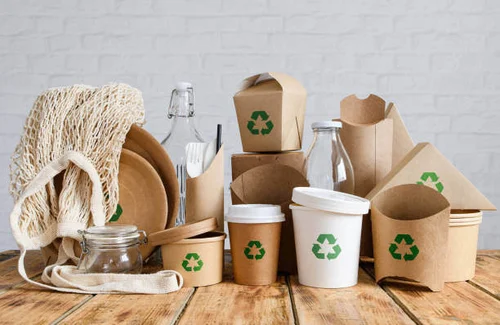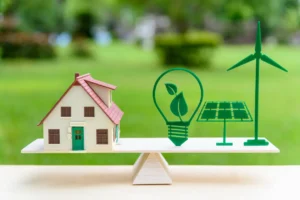Biodegradable material is becoming a vital component of the global fight against environmental pollution. These materials are broken down by microorganisms and leave behind water, carbon dioxide, and biomass. Biodegradable products are a viable alternative to traditional plastics and synthetics that take hundreds of years to decompose. They also align with eco-conscious goals. The shift to biodegradable products is not just a trend but a necessity for tackling critical challenges such as climate change, overflowing dumps, and ocean contamination.
Biodegradable materials are based on a simple but powerful idea: design products that fulfill their purpose while fading away without harmful traces. Biodegradable materials can be used for packaging, furniture, or utensils. Understanding what these materials are and the benefits they provide, as well as how they can be used, will help us make better choices for a healthier environment.
Biodegradable Materials Types
The biodegradable material comes in many forms. Each form has its own unique properties that are tailored to specific uses. Organic materials such as plant-based fibers, starches, and cellulose are some of the most common types. Biodegradable materials, such as cornstarch and sugarcane, are often made from these organic materials. They mimic the performance of traditional plastics while decomposing much quicker.
Another widely recognized category includes bio-based polymers like polylactic acid (PLA) and polyhydroxyalkanoates (PHA), which are gaining traction in both industrial and consumer applications. In textiles and construction, natural fibers like hemp, jute, and bamboo are emerging as viable alternatives. Innovations like biodegradable composites and mycelium-based (derived from fungi) are also pushing the limits of sustainable design.
The biodegradable materials are designed for specific applications while minimizing the environmental impact. The adaptability of the materials is demonstrated by their diversity, which can be used to replace harmful non-biodegradable alternatives in many industries.
Benefits of Biodegradable Materials
Biodegradable material has a number of advantages for the environment and economy. They reduce the amount of waste in landfills, and they also help to maintain natural ecosystems. These materials are much more biodegradable than conventional plastics. This reduces pollution and the burden on waste management systems.
Their reduced carbon footprint is another significant benefit. Biodegradables are often made of renewable resources, such as plants. This means that the production process produces fewer greenhouse gases than petroleum-based alternatives. Their natural decomposition also helps return nutrients to soils, supporting healthy ecosystems.
In an economic sense, industries that adopt biodegradable products can gain a competitive advantage in the market by appealing to environmentally conscious consumers. Businesses that invest in sustainable goods are also offered incentives by governments and organizations, creating a positive loop of feedback to encourage further development.
Biodegradable Materials: Applications
Biodegradable material is used in many industries. Biodegradable materials are used in packaging to replace single-use plastic bags, containers, and wraps. These options are especially valuable for businesses that deal with food, since they preserve the freshness of their products without causing environmental damage.
Biodegradable innovation is also a huge benefit to the healthcare industry. Biodegradable materials are being used to make surgical sutures and implants as well as drug delivery systems. They perform their function before dissolving safely in the body or environment.
Fashion, a notoriously environmentally conscious industry, slowly incorporates biodegradable materials like organic cotton, leather alternatives made of pineapple leaves, or mushroom fibers. In agriculture, biodegradable plant pots and mulch films contribute to sustainable farming. These applications show how biodegradable material can revolutionize industries and promote environmental health.
Challenges and Limitations
Biodegradable materials are not without challenges. Cost is a major issue. Biodegradable products are often more expensive because they require specialized technology and raw materials. The cost difference can discourage businesses and consumers.
The conditions for biodegradation are another challenge. Biodegradable materials require specific environments to decompose efficiently, like industrial composting facilities. These materials may not decompose properly if disposed of incorrectly. They could also contribute to waste accumulation.
Misconceptions among consumers about biodegradable materials can also lead to poor disposal practices. People may think that these materials can go anywhere, but they need to be composted in a controlled environment. In order to make biodegradable products a common solution, it is important that these issues are addressed.
Future Innovations
Biodegradable materials are rapidly evolving, as new innovations continue to break through. Researchers and scientists are constantly discovering new materials with improved properties. Biomaterials derived from lab-grown spider silk and cellulose are a great example of this. They offer new possibilities for functionality and sustainability.
The integration of biotechnology represents another exciting frontier. The advancements in microbial technology are allowing for the creation of biodegradable material with tailored properties such as increased strength or specific decomposition rate. Waste is also being used as a source of energy, with many companies using food scraps, agricultural byproducts, and algae to create eco-friendly products.
Collaborations between government, industry, and academic institutions will likely accelerate future breakthroughs. Incentives and policies that promote biodegradable products, coupled with the consumer’s demand for sustainability, will lead to a future in which these materials are dominant.
Consumer Awareness and Role
Consumers play an important role in the transition to biodegradable products. Education and awareness are key to helping people select sustainable alternatives and dispose of these responsibly. Understanding product labeling guidelines and composting guidelines will help consumers make choices that are environmentally friendly.
Collectively, individual actions, such as switching to eco-friendly products or choosing biodegradable packaging, can have a significant impact. Social movements and campaigns that promote responsible consumption can also have a significant impact on public behavior.
The consumer is not a passive participant but an active participant in shaping a sustainable tomorrow. Individual choices have a ripple effect on the system as a whole, so it is important that everyone take part in the transformation.
Conclusion
Biodegradable material is a major step forward in the pursuit of sustainability. These materials are a solution to the environmental crisis. They allow industries, governments, and individuals to reduce their environmental footprint. Their adoption, however, requires that they overcome challenges such as cost, awareness, and infrastructure limitations. Biodegradable materials’ potential can be fully realized by promoting innovation and consumer involvement.
FAQs
1. Can biodegradable material be considered eco-friendly?
Biodegradables are more eco-friendly than plastics. However, they depend on the conditions of composting and proper disposal. To maximize their benefits, they must be properly managed.
2. Can I compost biodegradable material at home?
Many biodegradable products can be composted at home, but others require industrial composting due to temperature and moisture requirements. You can find composting instructions on the product’s label.
3. Can biodegradable plastics be as durable as regular plastics
Biodegradable materials can be designed to last for a long time but will degrade under certain conditions, unlike traditional plastics.
4. Which industries use biodegradable material the most?
Biodegradable material is beneficial to many industries, including packaging, agriculture, healthcare, and fashion.
5. Can we expect the price of biodegradable products to drop?
As technology and production scale increases, costs should decrease. This will make biodegradable products more affordable for everyone.




